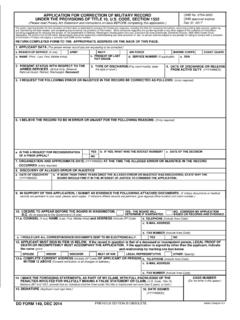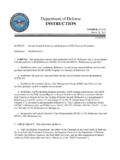Transcription of The Use of Inflation Indexes in the Department of Defense
1 INSTITUTE FOR Defense ANALYSESIDA Paper P-4707 Log: H 11-000167 May 2012 The Use of Inflation Indexesin the Department of DefenseCopyStanley A. Horowitz, Project LeaderAlexander O. GalloDaniel B. LevineRobert J. ShueRobert W. ThomasApproved for public release;distribution is This PublicationThis work was conducted by the Institute for Defense Analyses (IDA)under contract DASW01-04-C-0003, Task BA-7-3054, Cost Indices Assessment, for the Office of the Secretary of Defense , Cost Assessment and Program Evaluation (OSD CAPE). The views, opinions, and findings should not be construed as representing the official position of either the Department of Defense or the sponsoring you to Jerome Bracken, James R.
2 Dominy, Colin M. Doyle, StephanieS. Shipp, and John E. Whitley for performing technical review of this Notice 2011, 2012 Institute for Defense Analyses4850 Mark Center Drive, Alexandria, Virginia 22311-1882 (703) FOR Defense ANALYSESIDA Paper P-4707 The Use of Inflation Indexesin the Department of DefenseStanley A. Horowitz, Project LeaderAlexander O. GalloDaniel B. LevineRobert J. ShueRobert W. ThomasPreparation of this report/study cost the Department of Defense a total of approximately $310,000 in Fiscal Years 2010-2012 Generated on 2012 May 09 1332 RefID: 5-FA9AB9 Biii Executive Summary The 2009 Weapon Systems Acquisition Refor m A ct (WSARA) requires Department of Defense (DoD), Office of Cost Assessment and Program Evaluation (CAPE) to.
3 Periodically assess and update the cost (or Inflation ) Indexes used by the Department to ensure that such Indexes ha ve a sound ba sis and meet the Department s needs for realistic cost estimation. The objective of this pape r is to provide CAPE with a factual and ana lytical ba sis for responding to this pr ovision of WSARA. Since WSARA is concerned with the cost of major systems, much of our atte ntion will be given to the treatment of Inflation by Major D efense A cquisition Prog rams (MDAPs). Inflation Indexes and other price Indexes are de ve loped ba sed on changes, or expected cha nges, in the pr ices of the mix of goods be ing examined.
4 The pape r is careful to differentiate be tween the Inflation Indexes that cover the entire economy as a whole, and pr ice, or escalation, Indexes that cover specific classes of goods and services such as DoD proc ur ements. There are two major uses of DoD Inflation Indexes : Estimation of future budget requirements in then-year dollars. Calculation of increases in the cost of systems being acquired in constant ( Inflation -corrected) dollars, also termed real cost growth. Such calculations are used to identify systems whose real cost growth has breached Nunn-McCurdy thresholds and therefore need extra management attention, a focus of WSARA.
5 Regarding budgeting, the Offi ce of Management and Budget (OMB) requires eve ry agenc y to prepa re, each year, a policy budget tha t expresses the administration s most recent policy assumptions, including those concerning Inflation . The DoD Financial Mana gement Regulation (FMR) issued by the Office of the Under Secretary of Defense (Comptroller) (OUSD(C)) provides DoD Components with instruc tions on how to prepa re budget estimates within OMB guidelines. The FMR s guidance is unclear. It states that a DoD budget submission must reflect most likely or expected full costs. 1 The next pa ragraph, however, mandates the use of the OUSD(C)-pr ovided rates the appropriation-level deflator s for all accounts including determining the amount of pr ice escalation for p roc ur ement line items.
6 1 DoD Financial Management Regulation 7000 14-R, Volume 2A, Chapter 1, Section 010303, , 1 70. iv The OUSD deflators are calculated from OMB price Indexes for five categor ies of spending: military pay, civilian pay, fuel, medical expe nditures, and all other purcha ses. T he deflator for e ach appropriation is calculated by summing the f ive Indexes weight ed by the pe rcentage of the appropriation s spending in each category. The pr ice index for pr oc urement is ba sed entirely on the index for other purcha ses, which is ba sed on projections of the BEA (Bureau of Economic Analysis) deflator for the Gross Domestic Product (GDP).
7 In other words, Comptroller guidance assumes that pr ices for DoD pr oc ur ement ite ms will move in accord with pr ices in the economy as a whole, a questionable a ssumption. Some DoD organizations, such as the Naval Sea Systems Command (NAVSEA), the Nava l Air Systems Command (NAVAIR), and most Air For ce program offices, de ve lop specialized Inflation pr ojections for their pr ograms. These projections are usually highe r than those pr ovided by OUSD(C), and the pr og ram offices use them to ensure that their budget estimates reflect most likely or expected full costs. Other or ganizations, such as the Army, appear to use Comptroller rates.
8 In all cases, Comptroller rates are used to convert then- year dollar c osts to constant dollars. Returning to the two main uses of Inflation Indexes in DoD noted above, as long as pr oc urement pr ograms follow the guidanc e to reflect most likely or expected full costs, budgets will be pr epa red as accurately as budge ters are able to estimate future pr ice growth. Howeve r, if Comptroller rates are used to estimate future costs and those costs are expected to grow faster than the Comptroller rates, pr ograms will be systematic ally underfunded, leading to unnecessarily hi gh real program cost growth.
9 If the GDP deflator were a good overall proxy for DoD pr ocurement costs, calculating real DoD expe nditures using Comptroller rates would give a reasonabl y accurate indication of the real resources ava ila ble to the Department ; otherwise, it would not. Examination of inde xes for different types of items that DoD buys shows considerable variation. Some pr ices, like those for electronics, ha ve risen more slowly than the GDP deflator. Some, including ve hicles and ships, moved similarly to the GDP deflator. Some, perhaps including aircraft, have risen more rapidly. Alterna tive aircraft deflators be ha ve ve ry differently: one showing a high rate of pr ice increase and the other hardl y any increase.
10 This may reflect differences in the treatment of qualit y improvements. Inflation predictions are va luable aids in budget prepa ration only to the extent that they are accur ate. OMB pr ovides annual Inflation predictions for up to five years in the future. Looking over the 19 years from 1991 to 2009, OMB s initial for ecast (five years befor e the year in question) overestimated the change in the GDP de flator 10 times and underestimated it nine times. The absolute value of the average error was percent. Overestimates tended to have slightly larger errors than underestimates. v Our most important observa tions and suggestions include the f ollowing: The c ur rent practic e of s ome program managers t o use most likely or expected full costs in estimating then- year c osts for budgeting is appropriate, e ven when these c osts differ from those implied by Comptroller g uidanc e r egarding pr ice increases.

















